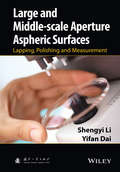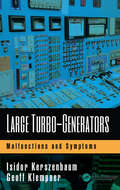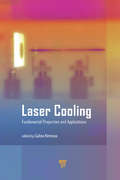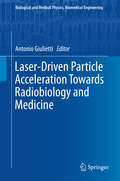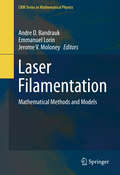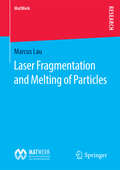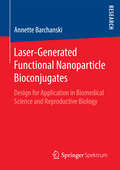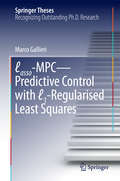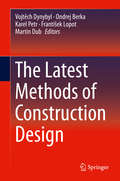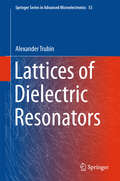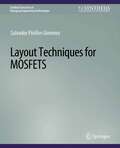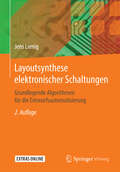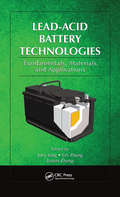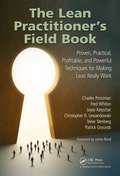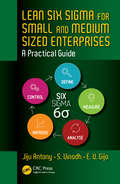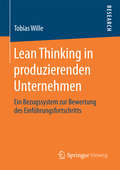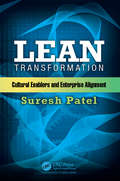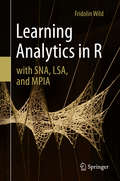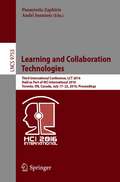- Table View
- List View
Large and Middle-scale Aperture Aspheric Surfaces: Lapping, Polishing and Measurement
by Shengyi Li Yifan DaiA complete all-in-one reference to aspheric fabrication and testing for optical applications This book provides a detailed introduction to the manufacturing and measurement technologies in aspheric fabrication. For each technology, both basic theory and practical applications are introduced. The book consists of two parts. In the first part, the basic principles of manufacturing technology for aspheric surfaces and key theory for deterministic subaperture polishing of aspheric surfaces are discussed. Then key techniques for high precision figuring such as CCOS with small polishing pad, IBF and MRF, are introduced, including the basic principles, theories and applications, mathematical modeling methods, machine design and process parameter selection. It also includes engineering practices and experimental results, based on the three kinds of polishing tools (CCOS, IBF and MRF) developed by the author’s research team. In the second part, basic principles of measurement and some typical examples for large and middle-scale aspheric surfaces are discussed. Then, according to the demands of low cost, high accuracy and in-situ measurement methods in the manufacturing process, three kinds of technologies are introduced, such as the Cartesian and swing-arm polar coordinate profilometer, the sub-aperture stitching interferometer and the phase retrieval method based on diffraction principle. Some key techniques are also discussed, including the basic principles, mathematical modeling methods, machine design and process parameter selection, as well as engineering practices and experimental results. Finally, the team’s research results about subsurface quality measurement and guarantee methods are also described. This book can be used as a reference for scientists and technologists working in optical manufacturing, ultra-precision machining, precision instruments and measurement, and other precision engineering fields. A complete all-in-one reference to aspheric fabrication and testing for optical applications Presents the latest research findings from the author’s internationally recognized leading team who are at the cutting edge of the technology Brings together surface processing and measurement in one complete volume, discussing problems and solutions Guides the reader from an introductory overview through to more advanced and sophisticated techniques of metrology and manufacturing, suitable for the student and the industry professional
Large and Middle-scale Aperture Aspheric Surfaces: Lapping, Polishing and Measurement
by Shengyi Li Yifan DaiA complete all-in-one reference to aspheric fabrication and testing for optical applications This book provides a detailed introduction to the manufacturing and measurement technologies in aspheric fabrication. For each technology, both basic theory and practical applications are introduced. The book consists of two parts. In the first part, the basic principles of manufacturing technology for aspheric surfaces and key theory for deterministic subaperture polishing of aspheric surfaces are discussed. Then key techniques for high precision figuring such as CCOS with small polishing pad, IBF and MRF, are introduced, including the basic principles, theories and applications, mathematical modeling methods, machine design and process parameter selection. It also includes engineering practices and experimental results, based on the three kinds of polishing tools (CCOS, IBF and MRF) developed by the author’s research team. In the second part, basic principles of measurement and some typical examples for large and middle-scale aspheric surfaces are discussed. Then, according to the demands of low cost, high accuracy and in-situ measurement methods in the manufacturing process, three kinds of technologies are introduced, such as the Cartesian and swing-arm polar coordinate profilometer, the sub-aperture stitching interferometer and the phase retrieval method based on diffraction principle. Some key techniques are also discussed, including the basic principles, mathematical modeling methods, machine design and process parameter selection, as well as engineering practices and experimental results. Finally, the team’s research results about subsurface quality measurement and guarantee methods are also described. This book can be used as a reference for scientists and technologists working in optical manufacturing, ultra-precision machining, precision instruments and measurement, and other precision engineering fields. A complete all-in-one reference to aspheric fabrication and testing for optical applications Presents the latest research findings from the author’s internationally recognized leading team who are at the cutting edge of the technology Brings together surface processing and measurement in one complete volume, discussing problems and solutions Guides the reader from an introductory overview through to more advanced and sophisticated techniques of metrology and manufacturing, suitable for the student and the industry professional
Large Turbo-Generators: Malfunctions and Symptoms
by Isidor Kerszenbaum Geoff KlempnerThis book presents a comprehensive, ordered relationship between malfunctions and symptoms occurring in large turbogenerators. With this book, the operator and/or engineer in a generating station could identify underlying causes of a developing component degradation or a failure quicker, which could potentially save both time and money and reduce the trial-and-error troubleshooting process. Large turbogenerators are the most important source of electricity. They can be found in thousands of power stations in every country. Forced outages, failures and degradation of these very expensive machines have an enormous aggregate cost to society. As such, any tool that can ameliorate loss of production by shaving time from troubleshooting activities, and avoiding unnecessary costs by detecting and promptly responding to component degradation, represents a step forward.
Large Turbo-Generators: Malfunctions and Symptoms
by Isidor Kerszenbaum Geoff KlempnerThis book presents a comprehensive, ordered relationship between malfunctions and symptoms occurring in large turbogenerators. With this book, the operator and/or engineer in a generating station could identify underlying causes of a developing component degradation or a failure quicker, which could potentially save both time and money and reduce the trial-and-error troubleshooting process. Large turbogenerators are the most important source of electricity. They can be found in thousands of power stations in every country. Forced outages, failures and degradation of these very expensive machines have an enormous aggregate cost to society. As such, any tool that can ameliorate loss of production by shaving time from troubleshooting activities, and avoiding unnecessary costs by detecting and promptly responding to component degradation, represents a step forward.
Laser Cooling: Fundamental Properties and Applications
by Galina NemovaIn the recent decades, laser cooling or optical refrigeration—a physical process by which a system loses its thermal energy as a result of interaction with laser light—has garnered a great deal of scientific interest due to the importance of its applications. Optical solid-state coolers are one such application. They are free from liquids as well as moving parts that generate vibrations and introduce noise to sensors and other devices. They are based on reliable laser diode pump systems. Laser cooling can also be used to mitigate heat generation in high-power lasers. This book compiles and details cutting-edge research in laser cooling done by various scientific teams all over the world that are currently revolutionizing optical refrigerating technology. It includes recent results on laser cooling by redistribution of radiation in dense gas mixtures, three conceptually different approaches to laser cooling of solids such as cooling with anti-Stokes fluorescence, Brillouin cooling, and Raman cooling. It also discusses crystal growth and glass production for laser cooling applications. This book will appeal to anyone involved in laser physics, solid-state physics, low-temperature physics or cryogenics, materials research, development of temperature sensors, or infrared detectors.
Laser Cooling: Fundamental Properties and Applications
by Galina NemovaIn the recent decades, laser cooling or optical refrigeration—a physical process by which a system loses its thermal energy as a result of interaction with laser light—has garnered a great deal of scientific interest due to the importance of its applications. Optical solid-state coolers are one such application. They are free from liquids as well as moving parts that generate vibrations and introduce noise to sensors and other devices. They are based on reliable laser diode pump systems. Laser cooling can also be used to mitigate heat generation in high-power lasers. This book compiles and details cutting-edge research in laser cooling done by various scientific teams all over the world that are currently revolutionizing optical refrigerating technology. It includes recent results on laser cooling by redistribution of radiation in dense gas mixtures, three conceptually different approaches to laser cooling of solids such as cooling with anti-Stokes fluorescence, Brillouin cooling, and Raman cooling. It also discusses crystal growth and glass production for laser cooling applications. This book will appeal to anyone involved in laser physics, solid-state physics, low-temperature physics or cryogenics, materials research, development of temperature sensors, or infrared detectors.
Laser-Driven Particle Acceleration Towards Radiobiology and Medicine (Biological and Medical Physics, Biomedical Engineering)
by Antonio GiuliettiThis book deals with the new method of laser-driven acceleration for application to radiation biophysics and medicine. It provides multidisciplinary contributions from world leading scientist in order to assess the state of the art of innovative tools for radiation biology research and medical applications of ionizing radiation. The book contains insightful contributions on highly topical aspects of spatio-temporal radiation biophysics, evolving over several orders of magnitude, typically from femtosecond and sub-micrometer scales. Particular attention is devoted to the emerging technology of laser-driven particle accelerators and their application to spatio-temporal radiation biology and medical physics, customization of non-conventional and selective radiotherapy and optimized radioprotection protocols.
Laser Filamentation: Mathematical Methods and Models (CRM Series in Mathematical Physics)
by Andre D. Bandrauk Emmanuel Lorin Jerome V. MoloneyThis book is focused on the nonlinear theoretical and mathematical problems associated with ultrafast intense laser pulse propagation in gases and in particular, in air. With the aim of understanding the physics of filamentation in gases, solids, the atmosphere, and even biological tissue, specialists in nonlinear optics and filamentation from both physics and mathematics attempt to rigorously derive and analyze relevant non-perturbative models. Modern laser technology allows the generation of ultrafast (few cycle) laser pulses, with intensities exceeding the internal electric field in atoms and molecules (E=5x109 V/cm or intensity I = 3.5 x 1016 Watts/cm2 ). The interaction of such pulses with atoms and molecules leads to new, highly nonlinear nonperturbative regimes, where new physical phenomena, such as High Harmonic Generation (HHG), occur, and from which the shortest (attosecond - the natural time scale of the electron) pulses have been created. One of the major experimental discoveries in this nonlinear nonperturbative regime, Laser Pulse Filamentation, was observed by Mourou and Braun in 1995, as the propagation of pulses over large distances with narrow and intense cones. This observation has led to intensive investigation in physics and applied mathematics of new effects such as self-transformation of these pulses into white light, intensity clamping, and multiple filamentation, as well as to potential applications to wave guide writing, atmospheric remote sensing, lightning guiding, and military long-range weapons.The increasing power of high performance computers and the mathematical modelling and simulation of photonic systems has enabled many new areas of research. With contributions by theorists and mathematicians, supplemented by active experimentalists who are experts in the field of nonlinear laser molecule interaction and propagation, Laser Filamentation sheds new light on scientific and industrial applications of modern lasers.
Laser Fragmentation and Melting of Particles (MatWerk)
by Marcus LauBased on the current state of the art Marcus Lau demonstrates an improved experimental design for defined laser irradiation of particles in liquid environment. The experimental results achieved with the designed reactor demonstrate how particle properties can be modified by defined laser energy dose input. By utilizing different model materials new insights into laser processing of particles in liquids are gained that allow an enhanced process understanding.
Laser-Generated Functional Nanoparticle Bioconjugates: Design for Application in Biomedical Science and Reproductive Biology
by Annette BarchanskiAnnette Barchanski deals with the question how to design nanoparticles for biomedical research. She considers properties such as size, charge, biocompatibility, and functionalization of nanoparticles from a biologist’s point of view in order to achieve specific cellular responses. The author discusses the structure-function relationship of nanoparticle conjugates derived from a laser-based fabrication method. Both the limits and perspectives of tunable conjugate functions are presented, providing a general outline for researchers to configure functionalized nanoparticles with a specifically optimized design for biomedical requests, e.g. in biomedical engineering regenerative science and reproductive biology.
Lasso-MPC – Predictive Control with ℓ1-Regularised Least Squares (Springer Theses)
by Marco GallieriThis thesis proposes a novel Model Predictive Control (MPC) strategy, which modifies the usual MPC cost function in order to achieve a desirable sparse actuation. It features an ℓ1-regularised least squares loss function, in which the control error variance competes with the sum of input channels magnitude (or slew rate) over the whole horizon length. While standard control techniques lead to continuous movements of all actuators, this approach enables a selected subset of actuators to be used, the others being brought into play in exceptional circumstances. The same approach can also be used to obtain asynchronous actuator interventions, so that control actions are only taken in response to large disturbances. This thesis presents a straightforward and systematic approach to achieving these practical properties, which are ignored by mainstream control theory.
The Latest Methods of Construction Design
by Vojtěch Dynybyl Ondrej Berka Karel Petr František Lopot Martin DubThis book is based on the 55th International Conference of Machine Design Departments 2014 (ICMD 2014) which was hosted by the Czech Technical University in September 2014. It features scientific articles which solve progressive themes from the field of machine design. The book addresses a broad range of themes including tribology, hydraulics, materials science, product innovation and experimental methods. It presents the latest interdisciplinary high-tech work. People with an interest in the latest research results in the field of machine design and manufacturing engineering will value this book with contributions of leading academic scientists and experts from all around the world.
Lattices of Dielectric Resonators (Springer Series in Advanced Microelectronics #53)
by Alexander TrubinThis book provides the analytical theory of complex systems composed of a large number of high-Q dielectric resonators. Spherical and cylindrical dielectric resonators with inferior and also whispering gallery oscillations allocated in various lattices are considered. A new approach to S-matrix parameter calculations based on perturbation theory of Maxwell equations, developed for a number of high-Q dielectric bodies, is introduced. All physical relationships are obtained in analytical form and are suitable for further computations. Essential attention is given to a new unified formalism of the description of scattering processes. The general scattering task for coupled eigen oscillations of the whole system of dielectric resonators is described. The equations for the expansion coefficients are explained in an applicable way. The temporal Green functions for the dielectric resonator are presented. The scattering process of short pulses in dielectric filter structures, dielectric antennas and lattices of dielectric resonators is discussed.
Layout Techniques in MOSFETs (Synthesis Lectures on Emerging Engineering Technologies)
by Salvador Pinillos GimenezThis book aims at describing in detail the different layout techniques for remarkably boosting the electrical performance and the ionizing radiation tolerance of planar Metal-Oxide-Semiconductor (MOS) Field Effect Transistors (MOSFETs) without adding any costs to the current planar Complementary MOS (CMOS) integrated circuits (ICs) manufacturing processes. These innovative layout styles are based on pn junctions engineering between the drain/source and channel regions or simply MOSFET gate layout change. These interesting layout structures are capable of incorporating new effects in the MOSFET structures, such as the Longitudinal Corner Effect (LCE), the Parallel connection of MOSFETs with Different Channel Lengths Effect (PAMDLE), the Deactivation of the Parallel MOSFETs in the Bird's Beak Regions (DEPAMBBRE), and the Drain Leakage Current Reduction Effect (DLECRE), which are still seldom explored by the semiconductor and CMOS ICs industries. Several three-dimensional (3D) numerical simulations and experimental works are referenced in this book to show how these layout techniques can help the designers to reach the analog and digital CMOS ICs specifications with no additional cost. Furthermore, the electrical performance and ionizing radiation robustness of the analog and digital CMOS ICs can significantly be increased by using this gate layout approach.
Layoutsynthese elektronischer Schaltungen: Grundlegende Algorithmen für die Entwurfsautomatisierung
by Jens LienigDieses viel gefragte Buch zur Elektronik-Entwicklung liegt nun in korrigierter zweiter Auflage vor. Es stellt verständlich und anschaulich die Wirkungsweisen und die grundlegenden Algorithmen vor, die „unter der Haube“ von CAD-Systemen für den Layoutentwurf bei Schaltkreisen und Leiterplatten ablaufen. Damit vermittelt das Buch die Fähigkeit, sowohl einfache Entwurfsprogramme selbst zu schreiben als auch zu erkennen, wie ein kommerzielles Layout-Entwurfssystem arbeitet. Dem Autor gelingt es dabei, die Brücke zwischen der Welt der Algorithmen, also dem „Innenleben“ von modernen Entwurfssystemen, und deren Anwendung zu schlagen. Zu jedem der wesentlichen Schritte bei der Layoutsynthese erfolgt in übersichtlichen Kapiteln neben einer Problembeschreibung eine Vorstellung der bedeutsamsten Algorithmen, die auch noch heutigen Entwurfswerkzeugen zugrunde liegen. Zahlreiche Beispiele und Aufgaben mit Lösungen dienen der Erhöhung der Anschaulichkeit. Zu jedem Kapitel ist ein umfangreicher Foliensatz über das Internet erhältlich.
Lead-Acid Battery Technologies: Fundamentals, Materials, and Applications (Electrochemical Energy Storage And Conversion Ser.)
by Joey Jung Lei Zhang Jiujun ZhangLead-Acid Battery Technologies: Fundamentals, Materials, and Applications offers a systematic and state-of-the-art overview of the materials, system design, and related issues for the development of lead-acid rechargeable battery technologies. Featuring contributions from leading scientists and engineers in industry and academia, this book:Describe
The Lean Practitioner's Field Book: Proven, Practical, Profitable and Powerful Techniques for Making Lean Really Work
by Charles Protzman Fred Whiton Joyce Kerpchar Christopher Lewandowski Steve Stenberg Patrick GroundsWhile there are numerous Lean Certification programs, most companies have their own certification paths whereby they bestow expert status upon employees after they have participated in or led a certain number of kaizen events. Arguing that the number of kaizen events should not determine a person's expert status, The Lean Practitioner's Field Book: Proven, Practical, Profitable and Powerful Techniques for Making Lean Really Work outlines a true learning path for anyone seeking to understand essential Lean principles.The book includes a plethora of examples drawn from the personal experiences of its many well-respected and award-winning contributors. These experts break down Lean concepts to their simplest terms to make everything as clear as possible for Lean practitioners. A refresher for some at times, the text provides thought-provoking questions with examples that will stimulate learning opportunities.Introducing the Lean Practitioner concept, the book details the five distinct Lean Practitioner levels and includes quizzes and criteria for each level. It highlights the differences between the kaizen event approach and the Lean system level approach as well as the difference between station balancing and baton zone.This book takes readers on a journey that begins with an overview of Lean principles and culminates with readers developing professionally through the practice of self-reliance. Providing you with the tools to implement Lean tools in your organization, the book includes discussions and examples that demonstrate how to transition from traditional accounting methods to a Lean accounting system.The book outlines an integrated, structured approach identified by the acronym BASICS (baseline, analyze, suggest solutions, implement, check, and sustain), which is combined with a proven business strategy to help ensure a successful and sustainable transformation of your organization.
The Lean Practitioner's Field Book: Proven, Practical, Profitable and Powerful Techniques for Making Lean Really Work
by Charles Protzman Fred Whiton Joyce Kerpchar Christopher Lewandowski Steve Stenberg Patrick GroundsWhile there are numerous Lean Certification programs, most companies have their own certification paths whereby they bestow expert status upon employees after they have participated in or led a certain number of kaizen events. Arguing that the number of kaizen events should not determine a person's expert status, The Lean Practitioner's Field Book: Proven, Practical, Profitable and Powerful Techniques for Making Lean Really Work outlines a true learning path for anyone seeking to understand essential Lean principles.The book includes a plethora of examples drawn from the personal experiences of its many well-respected and award-winning contributors. These experts break down Lean concepts to their simplest terms to make everything as clear as possible for Lean practitioners. A refresher for some at times, the text provides thought-provoking questions with examples that will stimulate learning opportunities.Introducing the Lean Practitioner concept, the book details the five distinct Lean Practitioner levels and includes quizzes and criteria for each level. It highlights the differences between the kaizen event approach and the Lean system level approach as well as the difference between station balancing and baton zone.This book takes readers on a journey that begins with an overview of Lean principles and culminates with readers developing professionally through the practice of self-reliance. Providing you with the tools to implement Lean tools in your organization, the book includes discussions and examples that demonstrate how to transition from traditional accounting methods to a Lean accounting system.The book outlines an integrated, structured approach identified by the acronym BASICS (baseline, analyze, suggest solutions, implement, check, and sustain), which is combined with a proven business strategy to help ensure a successful and sustainable transformation of your organization.
Lean Six Sigma for Small and Medium Sized Enterprises: A Practical Guide
by Jiju Antony S. Vinodh E. V. GijoIt is no secret that Lean Six Sigma (LSS) is not as popular with small and medium-sized enterprises (SMEs) as it is with larger ones. However, many SMEs are suppliers to larger entities who are pushing for superior quality and world-class process efficiencies from suppliers.Lean Six Sigma for Small and Medium Sized Enterprises: A Practical Guide provides a roadmap for the successful implementation and deployment of LSS in SMEs. It includes five real-world case studies that demonstrate how LSS tools have been successfully integrated into LSS methodology. Simplifying the terminology and methodology of LSS, this book makes the implementation process accessible. Supplies a general introduction to continuous improvement initiatives in SMEs Identifies the key phases in the introduction and development of LSS initiatives within an SME Details the most powerful LSS tools and techniques that can be used in an SME environment Provides tips on how to make the project selection process more successful This book covers the fundamental challenges and common pitfalls that can be avoided with successful introduction and deployment of LSS in the context of SMEs. Systematically guiding you through the application of the Six Sigma methodology for problem solving, the book devotes separate chapters to the most appropriate tools and techniques that can be useful in each stage of the methodology.Keeping the required math and statistics to a minimum, this practical guide will help you to deploy LSS as your prime methodology for achieving and sustaining world-class efficiency and effectiveness of critical business processes.
Lean Six Sigma for Small and Medium Sized Enterprises: A Practical Guide
by Jiju Antony S. Vinodh E. V. GijoIt is no secret that Lean Six Sigma (LSS) is not as popular with small and medium-sized enterprises (SMEs) as it is with larger ones. However, many SMEs are suppliers to larger entities who are pushing for superior quality and world-class process efficiencies from suppliers.Lean Six Sigma for Small and Medium Sized Enterprises: A Practical Guide provides a roadmap for the successful implementation and deployment of LSS in SMEs. It includes five real-world case studies that demonstrate how LSS tools have been successfully integrated into LSS methodology. Simplifying the terminology and methodology of LSS, this book makes the implementation process accessible. Supplies a general introduction to continuous improvement initiatives in SMEs Identifies the key phases in the introduction and development of LSS initiatives within an SME Details the most powerful LSS tools and techniques that can be used in an SME environment Provides tips on how to make the project selection process more successful This book covers the fundamental challenges and common pitfalls that can be avoided with successful introduction and deployment of LSS in the context of SMEs. Systematically guiding you through the application of the Six Sigma methodology for problem solving, the book devotes separate chapters to the most appropriate tools and techniques that can be useful in each stage of the methodology.Keeping the required math and statistics to a minimum, this practical guide will help you to deploy LSS as your prime methodology for achieving and sustaining world-class efficiency and effectiveness of critical business processes.
Lean Thinking in produzierenden Unternehmen: Ein Bezugssystem zur Bewertung des Einführungsfortschritts
by Tobias WilleMit der Bereitstellung der notwendigen Methoden in Form eines Bezugssystems bietet Tobias Wille eine einfache Möglichkeit zur ganzheitlichen Bewertung der Fortschritte während einer Unternehmenstransformation in Richtung Lean Thinking. Durch die Operationalisierung des Bezugssystems ergibt sich eine in der Praxis unkompliziert einsetzbare Bewertungslogik, die an das jeweilige Produktionssystem des zu bewertenden Unternehmens angepasst werden kann. Dabei gibt die Bewertung nicht nur Aufschluss über den aktuellen Stand der Einführung, sondern dient auch der Ableitung sinnvoller weiterer Schritte. Das Bezugssystem folgt dabei der Messung des organisationalen Wandels in den Dimensionen Verständnis, Umsetzung und Ergebnis, wobei jedes der 3 Module entsprechend ausgestaltet wird, sodass sich 9 methodische Bausteine ergeben.
Lean Transformation: Cultural Enablers and Enterprise Alignment
by Suresh PatelBooks in the Quality and Business Excellence series can help readers improve customer value and satisfaction by integrating the voice of the customer into design, manufacturing, supply chain, and field processes. Lean Transformation: Cultural Enablers and Enterprise Alignment is about the Lean system. It begins by describing the reasons why so many Lean implementations fail and explaining why managers need to focus their valuable time on early adopters rather than on trying to convert resistors.This book describes the guiding principles of the Shingo process for continuous improvement layout and evaluation. It examines the principles, systems, and tools of continuous improvement and demonstrates how to deploy these proven methods in plants and distribution centers.The book covers time-tested continuous improvement process tools and practices, including the visual workplace, mistake proofing, PDCA, 5S, Heijunka, standard work, Kaizen, and value stream mapping. It also examines Lean performance measures and introduces a comprehensive Lean tool assessment system.Presenting seven proven techniques for altering and guiding a Lean culture, the book identifies a formal process for overcoming common roadblocks. It also illustrates the proliferation of the Lean initiative across an organization's various sites. This book describes how proper assessment of Lean system tools can help your organization remain focused on system standardization and boost your organization’s sustainability efforts. It includes job descriptions of various roles in the improvement process, including those for Lean supervisor and Lean team leader, as well as a glossary that defines key terms.
Lean Transformation: Cultural Enablers and Enterprise Alignment
by Suresh PatelBooks in the Quality and Business Excellence series can help readers improve customer value and satisfaction by integrating the voice of the customer into design, manufacturing, supply chain, and field processes. Lean Transformation: Cultural Enablers and Enterprise Alignment is about the Lean system. It begins by describing the reasons why so many Lean implementations fail and explaining why managers need to focus their valuable time on early adopters rather than on trying to convert resistors.This book describes the guiding principles of the Shingo process for continuous improvement layout and evaluation. It examines the principles, systems, and tools of continuous improvement and demonstrates how to deploy these proven methods in plants and distribution centers.The book covers time-tested continuous improvement process tools and practices, including the visual workplace, mistake proofing, PDCA, 5S, Heijunka, standard work, Kaizen, and value stream mapping. It also examines Lean performance measures and introduces a comprehensive Lean tool assessment system.Presenting seven proven techniques for altering and guiding a Lean culture, the book identifies a formal process for overcoming common roadblocks. It also illustrates the proliferation of the Lean initiative across an organization's various sites. This book describes how proper assessment of Lean system tools can help your organization remain focused on system standardization and boost your organization’s sustainability efforts. It includes job descriptions of various roles in the improvement process, including those for Lean supervisor and Lean team leader, as well as a glossary that defines key terms.
Learning Analytics in R with SNA, LSA, and MPIA
by Fridolin WildThis book introduces Meaningful Purposive Interaction Analysis (MPIA) theory, which combines social network analysis (SNA) with latent semantic analysis (LSA) to help create and analyse a meaningful learning landscape from the digital traces left by a learning community in the co-construction of knowledge. The hybrid algorithm is implemented in the statistical programming language and environment R, introducing packages which capture – through matrix algebra – elements of learners’ work with more knowledgeable others and resourceful content artefacts. The book provides comprehensive package-by-package application examples, and code samples that guide the reader through the MPIA model to show how the MPIA landscape can be constructed and the learner’s journey mapped and analysed. This building block application will allow the reader to progress to using and building analytics to guide students and support decision-making in learning.
Learning and Collaboration Technologies: Third International Conference, LCT 2016, Held as Part of HCI International 2016, Toronto, ON, Canada, July 17-22, 2016, Proceedings (Lecture Notes in Computer Science #9753)
by Panayiotis Zaphiris Andri IoannouThis book constitutes the refereed proceedings of the Third International Conference on Learning and Collaboration Technologies, LCT 2016, held as part of the 18th International Conference on Human-Computer Interaction, HCII 2016, in Toronto, Canada, in July 2016, in conjunction with 14 thematically similar conferences. The 1287 papers presented at the HCII 2016 conferences were carefully reviewed and selected from 4354 submissions. The papers cover the entire field of human-computer interaction, addressing major advances in knowledge and effective use of computers in a variety of application areas. The papers included in this volume are organized in the following thematic sections: instructional design; interaction techniques and platforms for learning; learning performance; web-based, mobile and ubiquitous learning; intelligent learning environments; learning technologies; collaboration technologies; and cultural and social aspects of learning and collaboration technologies.
